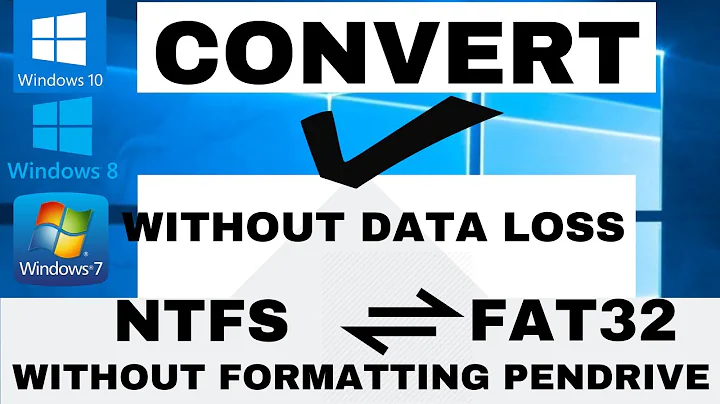Convert NTFS volume to exFAT (without losing contents)
Solution 1
To answer your question: no, there is no utility.*
I'd stick with NTFS. It's been around longer than exFAT, it is stable, and no one is forcing you to use the features like compression, security and encryption. It's also supported on a lot more platforms than exFAT, including Windows itself (notwithstanding the patches you can install).
exFAT is designed primarily for removable drives like USB thumb drives, so I'd use it for that, but not for a hard drive.
**(As @Moab points out in the comments, there are ways to do this using two separate conversions, from NTFS to FAT32, and then FAT32 to exFAT, but you'd be held ransom to FAT32's limitations during the conversion, which includes a maximum of 4GB on file sizes.)*
Solution 2
Assuming you are using Microsoft Windows, I have an idea for you. Since I was also looking for this solution and found nothing really working! I did a workaround.
What you can do is, Shrink the partition in your Portable, using Windows management tools (right click "computer" and goto Management, then goto "Disk Management"). To shrink the partition, click a partition that you want to shrink, and click on Shrink. Enter the size that is enough to copy all the data, then continue.
When you are done with creating another partition, move the data to the new partition, which is pretty time consuming I get that. What I did, is left my laptop for hours to get this done! Caution: Portables are not supposed to run for hours. I have reliable Portable so I did it.
Here you have two solutions! One to simply format using the right clicking on partition and click on format which will work on external hard drives only. However, I am also giving following solution for someone who may want to format the internal partition to exFat. Windows do not allow internal partitions to be formatted in ExFat by default so we need to follow Disk Part approach!
Note that, if you want to move large files to Portable or Internal Drive, set the Allocation Size to 4096 Bytes, as in the case of NTFS. When you are handling Diskpart, Unit=4096 is doing the same.
Follow as under:
1: Diskpart
2: List Disk
3: Select Disk x Note: x is the disk number you want to deal with.
4: list partition
5: select partition x Note: x is the partition number you want to format to exFat
6: Format FS=ExFat UNIT=4096 Quick
7: You are done!
Good Luck!
Solution 3
If you couldn't use of the above normal method, you can use of Parted.Magic tool for that goal. Download it's .iso file (it just need a little googling!) and burn it to a CD/DVD/USB stick then boot your computer from it. Then attach your HDD into computer and double click on partition Editor item (see this) Then you can see this window. Right click on the rectangle which is showing the size of your HDD, then convert it to whatever you like. PS. You should observe the considerations said about loosing data in above answer. Good luck.
Solution 4
I too migrated to an iMAC from a PC and since I had a lot of data over 4 hard drives (@ 4TB).
I moved them to an external USB 3.0 DAS enclosure, but needed a way for them to be read/write on a mac. I too read that exFAT was a better format than FAT32 and could be seen/written by BOTH PC & Mac. So I converted them all from NTFS to exFAT. At first it worked fine. Then, I lost a lot of my data! The weakness of exFAT, it only has one backup of its partition, so if this gets damaged, you lose your data!
I have since discovered that a this prog -> "NTFS for MAC" by Paragon which is great & so easy to use! Basically, it allows my Mac to read NTFS files so I no longer have to convert the NTFS to another format and my files are safer being on a more stable format. I am still trying to not only recover my lost files, but figure out how to reformat my hard drives back to NTFS!
So, I would strongly warn against converting your HD to exFAT! Just get the prog NTFS for MAC instead!
Related videos on Youtube
Admin
Updated on September 17, 2022Comments
-
 Admin over 1 year
Admin over 1 yearI have a 500GB external hard disk which I use mostly for storing movies/music and some backup. Since I have some rather large files I use NTFS on it, but don't need the security/compression/encryption features. I recently read about exFAT and as far as I understand it solves my shortcomings of FAT32, so decided to give exFAT a try.
Can anyone suggest an utility to convert my existing NTFS volume to exFAT (or vice versa) without losing contents?
-
Supercereal over 13 yearsEven with a utility you are still taking a gamble with your data. I can't stress enough that you should back up before migrating file systems. I have only attempted this once and it did not go well.
-
Supercereal over 13 years@Can lol :D good luck!
-
 Moab over 13 yearsNTFS > FAT32 >exFAT
Moab over 13 yearsNTFS > FAT32 >exFAT -
 Admin over 13 years@Moab - is that even possible? Also, if he's got >4GB files it won't work.
Admin over 13 years@Moab - is that even possible? Also, if he's got >4GB files it won't work. -
 Moab over 13 years@ Randolf, I have never done it, but I could find nothing on going from NTFS directly to exFAT, but did for doing it in 2 steps. Yes 4gb files would need to be moved elsewhere.
Moab over 13 years@ Randolf, I have never done it, but I could find nothing on going from NTFS directly to exFAT, but did for doing it in 2 steps. Yes 4gb files would need to be moved elsewhere. -
Synetech over 13 years@Moab, FAT32>exFAT? @Can, if you have another storage device, you could transfer your files to that, format the drive, then transfer them back (depending on how much free space you have available, how much data is on the drive in question, and how much time you are willing to spend on it).
-
 Admin over 13 years@Moab - I saw the two-step process too, but I think it's much wiser for @Can to stay on NTFS and leave well-enough alone :-). P.S. I updated my answer to include it, with the proviso of the 4GB limit.
Admin over 13 years@Moab - I saw the two-step process too, but I think it's much wiser for @Can to stay on NTFS and leave well-enough alone :-). P.S. I updated my answer to include it, with the proviso of the 4GB limit. -
 Admin over 12 yearsAcronis DiskDirector allows for filesystem conversion without losing data.
Admin over 12 yearsAcronis DiskDirector allows for filesystem conversion without losing data. -
JW0914 almost 5 yearsYou're going to run into issues eventually with an HDD formatted as exFAT due to licensing. exFAT is not free, unlike NTFS or FAT32, and in order for it to be supported by an OS or firmware, it must be licensed from Microsoft, resulting in several OSes and firmware simply not supporting it. NTFS is supported across Linux and BSD (incl Apple's OS, which is built upon BSD).
-
-
psusi over 13 yearsThe conversion between fat and ntfs used to be one way. Has that changed in recent version of windows?
-
 Admin over 13 yearsNo there is no method in Windows to do this. It would be a third-party product.
Admin over 13 yearsNo there is no method in Windows to do this. It would be a third-party product. -
maayank about 12 years"It's also supported on a lot more platforms than exFAT, including Windows itself (notwithstanding the patches you can install)." The lack of proper Mac support is a real practical problem of using NTFS.
-
Bret Fisher about 12 yearsNote my real world experiences of ExFAT on Windows 7 and Mac Lion 10.7.4 have me going back to NTFS. ExFAT works but I randomly get corruption on Mac, likely due to it being a laptop and if I ever disconnect w/o first waking it up and unmounting I get corruption and lost files 50% of time. Not sure if that is the same on Windows, but now I'm switching to NTFS and just using Mac over SMB to access the drive rather then direct USB. I'm having to copy files off of ExFAT, re-format, then copy back...
-
 tvk over 8 years@BretFisher I think disconnecting without first unmounting tends to corrupt files regardless of file systems and operation systems?
tvk over 8 years@BretFisher I think disconnecting without first unmounting tends to corrupt files regardless of file systems and operation systems? -
hippietrail about 8 years@FangJing: No, I believe any journaled filesystem should never suffer corruption from this, bugs notwithstanding. Current versions of NTFS, HFS+ and many *nix filesystems have journaling but no FAT filesystem has it.
-
 ScottC almost 8 yearsI can't write to my external HDD fro my Mac because its NTFS
ScottC almost 8 yearsI can't write to my external HDD fro my Mac because its NTFS -
 Ben Voigt almost 8 years@hippietrail: Most journaling will protect the filesystem's internal data structures, but not file content.
Ben Voigt almost 8 years@hippietrail: Most journaling will protect the filesystem's internal data structures, but not file content. -
 Ruslan almost 5 yearsThis is not conversion, it's creation from scratch.
Ruslan almost 5 yearsThis is not conversion, it's creation from scratch. -
 Ruslan almost 5 yearsThis of course requires having at least the amount of free space able to hold a copy of the data. Otherwise, you might try doing it in multiple steps (if Windows tools can enlarge partitions): copy a large file, shrink the original FS, expand the new one, copy another file etc. .
Ruslan almost 5 yearsThis of course requires having at least the amount of free space able to hold a copy of the data. Otherwise, you might try doing it in multiple steps (if Windows tools can enlarge partitions): copy a large file, shrink the original FS, expand the new one, copy another file etc. . -
Imran Faruqi almost 5 yearsCertainly. Most people are having one or two partition in their portable and that's why I suggested to shrink the partition and then move the data between partition. If the questioner's portable is not half empty or more than that, it would be hectic to follow this approach as it will require him to transfer partial data to computer or other storage drives. Off the topic: I used to convert partition to ExFat because Linux did not support NTFS for writing content but since linux has started supporting NTFS, I would rather use NTFS.
-
 174140 almost 5 yearsPlease don't post text walls.
174140 almost 5 yearsPlease don't post text walls. -
Leo Fisher almost 3 yearsdownvoted, what "a lot of data" did you lose?
-
HerbM over 2 yearsI can't help commenting on this apparently written in 2019 (not 1989): "Caution: Portables are not supposed to run for hours.": My laptop runs for days or weeks and only reboots for updates and similar. Even unplugged, I expect it to run for hours and then sleep/hibernate when the battery runs low until I restore power.
-
HerbM over 2 yearsI upvoted on the assumption it would really work (without checking it myself) and that it seems to be free -- so it's worth trying in any case. Don't know why this didn't receive any UP or DOWN votes -- it's either wrong or right.
-
Imran Faruqi over 2 yearsI understand. I have Seagate Backup Plus 4 TB. My personal experience and research on Seagate have always been satisfactory. There are Hard disks that can run for longer and there are some which aren't supposed to be running for hours. But, their products are reliable.
-
imz -- Ivan Zakharyaschev over 2 yearsIs there a way to move the new exfat partition to the beginning of the disk and extend it then? If not, this approach is feasible, but requires copying the data 3 times: old ntfs partition at the beginning of the disk -> temporary partition at the end -> new exfat partition at the beginning
-
imz -- Ivan Zakharyaschev over 2 years@hippietrail AFAIK ntfs-3g under Linux doesn't make use of the journalling, so I suffered some problems. I want to try exfat for the external drive for the reason that there must be a native Linux driver for it, supported by Samsung and used by them in production. I hope it'll be easier to recover from errors under Linux with the native driver than with ntfs-3g. However, if exfat doesn't employ journalling, it must be less reliable by design than any journalling FS...
-
Imran Faruqi over 2 years@imz--IvanZakharyaschev I guess, we can't. Disk defragment is there to manage space for us. If you'd like, you can do the defragment before doing all this. but it doesn't matter when you are extending. Eventually, the available space to extend to, will be similar. Or perhaps, I did not fully understand you.
-
imz -- Ivan Zakharyaschev over 2 years@ImranFaruqi I meant: after you shrink the old ntfs partition (following your proposed method), the free space is at the end of the disk. That's where you can create the new exfat partition (and copy the data there). But if you want to eventually have one big exfat partition on the whole disk, you'll need to move the new exfat partition to the beginning somehow.




